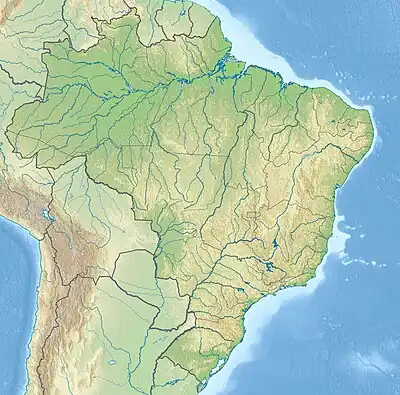Phasmahyla cruzi
Phasmahyla cruzi is a species of frog in the subfamily Phyllomedusinae.[2][3] It is endemic to Brazil and solely known from the vicinity of its type locality, Rio das Pedras Reserve in the municipality of Mangaratiba, Rio de Janeiro state.[2] The range extends into the adjacent Paraty municipality.[1] This species is named for Carlos Alberto Gonçalves da Cruz, Brazilian herpetologist.[1][4] The common name Mangaratiba tree frog has been proposed for it.[4]
| Phasmahyla cruzi | |
|---|---|
| Scientific classification | |
| Domain: | Eukaryota |
| Kingdom: | Animalia |
| Phylum: | Chordata |
| Class: | Amphibia |
| Order: | Anura |
| Family: | Hylidae |
| Genus: | Phasmahyla |
| Species: | P. cruzi |
| Binomial name | |
| Phasmahyla cruzi Carvalho-e-Silva, Silva, and Carvalho-e-Silva, 2009[1] | |
 | |
| Phasmahyla cruzi is only known from near Rio das Pedras Reserve in southeastern Brazil | |
Description
Adult males measure 31–34 mm (1.2–1.3 in) and adult females, based on a single specimen, about 42 mm (1.7 in) in snout–vent length. The body and limbs are slender. The snout is short and truncated. The eyes are large and protuberant. The tympanum is small and its upper part is hidden by the supratympanic fold. The fingers and the toes bear small terminal discs. No webbing is present. Skin is smooth. Dorsal coloration is light to dark green with light to dark purple dots. The concealed parts of the limbs and flanks are orange with many small purple spots. The belly is cream. The iris is silver-gray.[1]
Tadpoles of Gosner stage 37 measure 40–46 mm (1.6–1.8 in) in total length, which includes the 13–16 mm (0.5–0.6 in) ovoid body. The mouth is anterodorsal and has a funnel-shaped dermal fold.[1]
Habitat and conservation
Phasmahyla cruzi have been collected from a stream with a sandy bottom at an elevation of about 200 m (660 ft) and higher. In general, Phasmahyla are associated with mountain streams in the Atlantic Forest domain.[1]
As of April 2022, this species has not been assessed for the IUCN Red List of Threatened Species.[5]
References
- de Carvalho-e-Silva, Ana Maria Paulino Telles; da Silva, Guilherme Ramos & de Carvalho-e-Silva, Sergio Potsch (2009). "A new species of Phasmahyla Cruz, 1990 from the Atlantic Forest in the state of Rio de Janeiro, Brazil (Amphibia, Hylidae, Phyllomedusinae)". Zootaxa. 2120 (1): 15–26. doi:10.11646/zootaxa.2120.1.3.
- Frost, Darrel R. (2022). "Phasmahyla cruzi Carvalho-e-Silva, Silva, and Carvalho-e-Silva, 2009". Amphibian Species of the World: an Online Reference. Version 6.1. American Museum of Natural History. doi:10.5531/db.vz.0001. Retrieved 19 April 2022.
- "Phasmahyla cruzi". AmphibiaWeb. University of California, Berkeley. 2022. Retrieved 19 April 2022.
- Beolens, Bo; Watkins, Michael & Grayson, Michael (2013). The Eponym Dictionary of Amphibians. Pelagic Publishing. p. 48. ISBN 978-1-907807-42-8.
- "IUCN Red List of Threatened Species". Retrieved 19 April 2022.